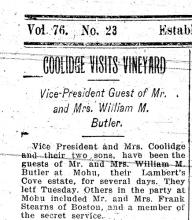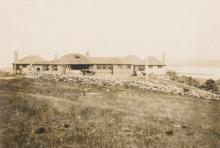Mohu, beautiful Mohu, the 218-acre property at Lambert’s Cove famous during the lifetime of Sen. William M. Butler and Mrs. Butler, is exciting attention again in this era of dramatic changes on Martha’s Vineyard. The property is, perhaps, a microcosm or a recapitulation of forces which have been determining in Island history.
First, long ago beyond existing annals or memories, the region of Lambert’s Cove was divided into farmsteads or homestead places for fishermen-farmers or for early long-shore chandlers or artisans who made a living from the ships that passed by or anchored in the Cove. At this place, Warner F. Gookin, Island historian, thought Gosnold’s men had landed in 1602. If so it was here, and understandably to anyone who visits the place today, that John Brereton, gentleman, first formed the impression that led him to write, “This is the goodliest land ever we saw...” and James Pond, named for King James, would have had priority among the “standing lakes of fresh water.”
History moved along at the slow pace of the sixteenth and seventeenth centuries, and then Senator Butler, moved by something of the same land hunger that actuated Nathaniel Southgate Shaler in his buying and uniting North Shore farms to the westward into Seven Gates Farm, bought property after property to be merged into the new Mohu. It used to be said, say 60 years ago, that Senator Butler wanted to own everything that adjoined him. But this was said in the quiet joking Vineyard way, for everyone believed then that there was plenty of Island land.
The Big Questions
Now, apparently, Mohu faces another division, and the big question for the property itself and for the Vineyard is how it will be divided. Mrs. Elizabeth Macfarlane, in whose ownership the beautiful region now is, said last week that she had held several conversations with directors of the Vineyard Open Land Foundation “and other groups” interested in planning the property in a way compatible with the best interests of the Island.
Mohu, one way or another, can largely determine the future of the Vineyard’s North Shore between Makonikey and Paul’s Point. The property has 900 feet of shore, but it has, more decisively, the overseeing slopes and hills, ponds, the west side of James Pond, and the natural features that make up the character of the historic region.
The course of accumulation proceeded in this way, representing similar evolutions in the country at large as well as on the Vineyard:
In 1909 William M. Butler bought the Great Hill Pasture and beach lot of John Cottle. These Cottle lands went back in Lambert’s Cove history through the ownership of John Cottle Sr., Davis Cottle, and Shubael Cottle to the tract set off to the Praying Indians in 1709.
John Cottle’s pasture lands included about 43 acres and Marine Hill, as he called it, though the eminence usually went by the name of Great Hill. The name Marine Hill was intended to distinguish it from Great Hill of which it was, by definition, only a part. The pasture was enclosed by a fence except on the east and “where the line crosses Blood Sucker Pond.”
The Cottle beach and marsh were on the west side of James Pond.
Title searches made for Senator Butler brought out such names as Mot’s Hill Woodlot, the Cove Meadow, and James Pond Meadow. They traced back to Charles Lambert and others of that surname for whom Lambert’s Cove was christened.
A 1909 purchase of land was on the west side of James Pond “being the northerly part of the Elisha Lambert pasture, so called.” It involved old and flavorsome phrases such as: “beginning at a stake and stones standing about ten feet westerly from an old cherry tree,” Blood Sucker Pond again, “a barway in a fence” and “a water fence at the lands of Susie N. Smith.”
In 1910 marsh or meadow land on James Pond, formerly the property of Alfred Norton, was acquired from Joseph C. Mingo who was to be the last all-year Indian resident of Christiantown. The next year Mr. Butler bought two lots near James Pond from H. Nelson Luce and Otis B. Luce, one of them described as “a lot of swamp pasture and meadow land.” In 1911 also three more parcels were acquired from John Cottle, bordering James Pond and the Sound. One bound mentioned in the deed was the “corner of a wall enclosing an old orchard.”
Early in 1912 J. Gordon Mason of Waterbury, guardian of Amy C. Mason, sold to Mr. Butler a lot of the southwest side of James Pond known as the Swale Place. This was of seven acres, and another deed from Mr. Mason in 1913 added more land with buildings, extending to a bluff above the shore; this had been part of the John Cottle property.
In April, 1914, Mr. Butler acquired from Frederick B. Fisher of Hingham land “beginning at Vineyard Sound, southerly across low beach” and from Ernest Norton in 1915 tracts known colorfully as “The Island,” “the North Cove,” and “the Flat.”
Purchases in 1917 were from Prof. and Mrs. Percy J. Moore, about eight acres at Paul’s Point; from Almira and Lena Cottle about 25 acres adjoining the former Moore land; and from Mrs. William Barry Owen some 60 acres with buildings including the once famous Red Lodge lot.
So it went, until the final important acquisitions were in 1919 and 1920, and Moho stood complete, a magnificent region pieced together through search, patience, and a devotion to the shore, marsh, woodland, and meadow which in times past had been esteemed of little value. Their new value came then through the integrity and proportion they had gained.
Some lovers of the Island now wonder, if, following the pattern of the Shaler property to the westward and its evolution into Seven Gates Farm, Mohu may become another instance of that concept. But the questions are many, and destiny can act with little warning.









Comments